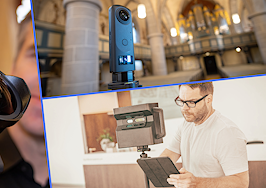For nearly a year, Americans have been told to stay home to slow the spread of COVID-19. All this time spent homebound has certainly inspired new consumer behaviors and expectations, but it’s also given way to a unique set of digital engagement strategies that will forever impact business product strategy.
While smartphone use was already ubiquitous before the pandemic, everyone has now become even more reliant on their devices to work, learn, shop, travel and just live. These new consumer needs and values, coupled with digital innovation to meet people where they are, have come to shape what’s now known as the “homebody economy.”
We’ve witnessed firsthand how this behavior has impacted the real estate space. As our lives became more sedentary and localized, people reconsidered the physical location where they spent the majority of their time — their homes.
The right living space (and changing it to accommodate a new set of ideals) became a very real need, whether it was because people needed more room to accommodate the family being in the same space 24 hours a day, or to relocate to a more affordable or desirable area.
Suffice to say, the homebody economy took no prisoners. Businesses across retail, travel, food service, real estate and nearly every other industry have iterated on or upgraded their platforms and services to better engage people in this new way of living (and thriving) during a pandemic.
That said, not all of them have tapped into the right approach. Navigating the homebody economy is not without challenges, but success can be achieved by applying a core set of principles and following some basic do’s and don’ts.
Do: Give people everything they need — and nothing they don’t
The severity of the pandemic has made people less tolerant of fluff. Deliver users the information they need to make a decision, and immediately benefit from your product, without layering on bells and whistles that aren’t immediately relevant to them.
One example of a company doing it right: Uber. Stay-at-home orders notwithstanding, many still rely on rideshare services for transportation to get food, get household essentials or simply get from point A to point B safely.
Though Uber saw its business decline by 70 percent during the pandemic, the service is leaning into their safety and cleanliness messages over other differentiators of the service. Uber acutely understands that these assurances are what their riders need right now, eschewing carpools, parties and surge pricing messages for customer communication about safety.
Put into practice: Be selective and prioritize the most relevant things for right now. For example, although we had assumed print marketing materials would continue to be an essential tool for agents, we quickly leaned into digital marketing strategies when stay-at-home orders were put into effect.
Give agents what they need by making tools like downloadable social media content and other digital materials to showcase properties available to them.
Do: Meet people where they are
Smart service providers are designing around their customers’ immediate needs, meeting them in the exact place and moment where they are, rather than driving them to a new interface or experience.
Supermarkets and big-box stores are visible examples of this trend, with many people avoiding crowding the aisles alongside scores of strangers. Within a few months of the pandemic, Target reengineered its entire delivery cycle for customers (including stocking, parking lot organization, app functionality and customer messaging) to deliver a fast and easy contactless shopping experience.
With a few taps in the app, an order can be placed for same-day pickup without customers ever having to leave the safety of their cars. The new offering enabled customers to inform Target employees that they were on their way, in the parking lot, and ready for pickup with a single pickup code.
By walking in their customers’ shoes, Target became a prime example of understanding where to meet them where they were (both literally and figuratively).
Put into practice: Like Target, retailers across the gamut have had to evolve from product to service providers during the pandemic, and it’s likely your business pivoted in a similar fashion.
Keep this flexibility in mind when it comes to your product strategy by meeting users where they are throughout their journey. Consider things like the personalization of your onboarding experience. Are you taking into account the varying levels of expertise of your users? And is your messaging appropriate?
For example, we deemphasized prompts alongside listings to “book a showing” in favor of 360 videos and other rich digital imagery that mimicked the buyers’ experience of touring a home. Taking into account parents’ participation in their children’s Zoom schooling, we also extended the workday, with agent education and training at off hours.
Do: Make saving people’s time paramount
In and out of a pandemic, people are juggling work and home life — and not always with success. With constant change a near certainty in life (exacerbated by our current world order), improvisation and reevaluation are necessities.
This new reality has never been more true when it comes to our homes. People are reevaluating and reimagining their ideal living space. Millennials in particular, both first-time homebuyers and growing young families, are looking for new homes to escape crowded spaces — and quickly.
We recognized the time-saving measures required to meet this exploding demand and elevated agents’ essential business needs front and center in the platform. By simplifying design and focusing on key functionality — like market data and analysis, marketing automation, and a valet program — rather than every potential bell and whistle, we’ve sped up the work process and consolidated time into results for agents.
Put into practice: By prioritizing your customer’s essential needs and showcasing the corresponding features, you can save time and shorten their path to results.
Keeping this in mind, we simplified our app and platform design, and focused on key functionality like tighter integration with tools for contracts and other important documents.
We also had transaction coordinators and our compliance team available 24/7, so agents could hit the ground running upon joining, and close deals wherever, whenever.
Don’t: Take advantage of people’s desperation and wallets by layering on fees (just because you can)
Record numbers of consumers are now desperately reliant on online shopping and delivery services, and are also over-purchasing with the intent to return. Digital returns solution Returnly found that record-breaking holiday sales last year caused a huge backlog of returns, leading to unpredictability and longer refund times for consumers — which could ultimately push them toward not purchasing from that brand again.
The brands that are winning new customers and their loyalty during this time are the ones that make it as easy as possible for customers to buy and return, lengthen the returns window, and eliminate unnecessary penalties and other fees.
Put into practice: Elevating your users needs over the upsell goes a long way when it comes to customer loyalty. For example, as lockdown orders continued, we offered a number of premium services (such as access to in-house designers, custom logo development, and home staging and design services) at no additional cost to our agents.
Don’t: Design products that aren’t human-centered
When the pandemic hit, airlines lost between 60 to 70 percent of their business. We were told to stay home for our safety and the safety of others, but airlines needed travelers in the air to stay afloat.
To ease flyer concerns, airlines were quick to share research demonstrating air safety, messaging about hygienic travel and the promise of socially distanced flights. While leaving the middle seat open was a key selling point, most U.S. airlines have been forced to resort back to selling all available seats, and relying on cleaning procedures and customer mask regulations to ensure passenger safety.
Designing products and services for our new reality requires the foresight to build something new, better and ultimately, human-centric. Otherwise, don’t bother.
Take Italy’s Avio Interiors and London’s Factory Design, two companies that released designs for new airplane seats that could reduce the transmission of germs among passengers. Both are not only working to improve something we all hate — the middle seat — but designing features that key into what travelers need now to feel safe in the skies.
Put into practice: Now and post-COVID, businesses should continue to focus on the human experience and adding value to their customers’ lives — and this doesn’t have to mean reinventing the wheel (or airplane seat).
Beef up the customer experience by setting a strategy that provides solutions to diverse wants and needs, or look at ways to increase support at times when it’s needed most.
If we can find a silver lining in the pandemic, it’s that we’ve had to consider how to build meaningful connections with our agents from afar. Empathy was paramount on that front, understanding each agent’s unique persona, considering their feelings and primary needs in any given situation, and then showing up for them when they needed us most.
It’s been estimated that the pandemic accelerated our use of digital tools by nearly a decade. I suspect many of you feel like you’re running with scissors as you navigate the fast-paced changes around us, while also trying to deliver your users value.
In order for work-from-home consumers to adopt new technologies and services, they have to work for our lives today. Navigating the homebody economy is new for all of us, but success will come when you get back to the basics: Offer something people need, meet them where they are, save them time and money and design with humans at heart.
Nicole Baez Sweat is a Group Product Manager with Avenue 8 in San Francisco. Connect with her on LinkedIn or Instagram.













